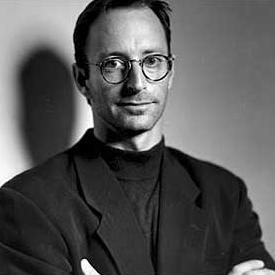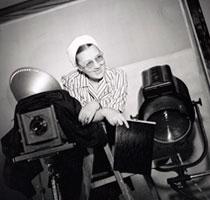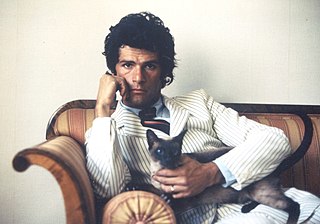
Herbert Ritts Jr. was an American fashion photographer and director known for his photographs of celebrities, models, and other cultural figures throughout the 1980s and 1990s. His work concentrated on black and white photography and portraits, often in the style of classical Greek sculpture, which emphasized the human shape.

Helmut Newton was an Australian photographer. The New York Times described him as a "prolific, widely imitated fashion photographer whose provocative, erotically charged black-and-white photos were a mainstay of Vogue and other publications."

Bruce Weber is an American fashion photographer and occasional filmmaker. He has made ad campaigns for Calvin Klein, Ralph Lauren, Pirelli, Abercrombie & Fitch, Revlon, and Gianni Versace, and made work for Vogue, GQ, Vanity Fair, Elle, Life, Interview, and Rolling Stone magazines.

Fashion photography is a genre of photography that portrays clothing and other fashion items. This sometimes includes haute couture garments. It typically consists of a fashion photographer taking pictures of a dressed model in a photographic studio or an outside setting. It originated from the clothing and fashion industries, and while some fashion photography has been elevated as art, it is still primarily used commercially for clothing, perfumes and beauty products.
Steven Meisel is an American fashion photographer, who obtained popularity and critical acclaim with his work in Vogue and Vogue Italia as well as his photographs of friend Madonna in her 1992 book, Sex. He is now considered one of the most successful fashion photographers in the industry. He used to work regularly for both US and Italian Vogue, and W and now exclusively for British Vogue.

Louise Emma Augusta Dahl-Wolfe was an American photographer. She is known primarily for her work for Harper's Bazaar, in association with fashion editor Diana Vreeland. At Harper's Bazaar she pioneered a new standard in color photography.

Max Vadukul, is a British-Indian photographer based in Milan, Italy. Noted for his black-and-white imagery, Vadukul expressed his preference for monochrome photography as superior, stating, “Black-and-white is king. King of kings. Color is Commercial”, in an interview with J’aipur journal. He holds the distinction of being the first photographer of Indian origin to publish in the editions of Paris, Italian, British, and American Vogue, photographing celebrated figures such as Amy Winehouse, Tilda Swinton, Beyonce, Paul McCartney, Natalie Portman, Tom Hanks, Justine Timberlake, and many more. Sting has described his photography as a sort of "On the move style". The National Geographic channel produced a feature documentary on Vadukul in 2000 about the improbable arc of his life after Africa; the documentary continues to air around South Asia today.

Samuel Joseph Haskins, was a British photographer, born and raised in South Africa. He started his career in Johannesburg and moved to London in 1968. Haskins is best known for his contribution to in-camera image montage, Haskins Posters (1973) and the 1960s figure photography trilogy Five Girls (book) (1962), Cowboy Kate & Other Stories (1964) and November Girl (book) (1967), plus an ode to sub-saharan tribal Africa "African Image (book) (1967).

Nude photography is the creation of any photograph which contains an image of a nude or semi-nude person, or an image suggestive of nudity. Nude photography is undertaken for a variety of purposes, including educational uses, commercial applications and artistic creations.
Steven Klein is an American photographer and videographer based in New York City. He has worked with numerous pop culture figures, including American singer-songwriter Madonna.

Jerry Avenaim is an American photographer best known for his fashion and celebrity images.
Marco Glaviano is an Italian photographer and architect, who has worked for leading fashion magazines and brands on both sides of the Atlantic, and with many of the world's best known models. He has been a pioneer of digital photography, being the first to publish a digital picture in American Vogue in 1982. His photographs of fashion, celebrities, landscapes, and jazz have appeared in numerous museums and are represented in private and public collections worldwide. He is the co-founder of Pier 59 Studios in New York City, which he also helped design.

Jean-François Lepage, is a French photographer and painter. He lives and works in Paris.
George Holz was born in Oak Ridge, Tennessee, graduated from the Art Center College of Design in Pasadena, California, and assisted for Helmut Newton, whom he credits with guiding his career. As a fledgling photographer, he lived in Milan and Paris, where he shot beauty and fashion for major European magazines such as Italian Vogue and French Elle. Afterward, he moved to New York City, where he set up his famous studio on Lafayette Street, traveling frequently to Los Angeles and Europe to shoot fashion, advertising, and portraiture for major publications such as Vanity Fair and Harper's Bazaar. His fine-art nudes have been exhibited in galleries and museums around the world. His shows have included “Original Sin” and “Three Boys from Pasadena – A Tribute to Helmut Newton” with fellow Art Center alumni Just Loomis and Mark Arbeit. Holz has collected a variety of prestigious industry awards over the years including a Grammy and a Clio.

Günter Rössler was a German photographer who made a name for himself especially in the field of nude art photography. A pioneer of nude photography in East Germany and notable fashion photographer, Rössler was often referred to by the media as the Helmut Newton of East Germany, stylized since Playboy published in 1984 a photo-gallery titled: Mädchen der DDR. Rössler however, never liked this comparison with Newton, saying: "with Newton the pose dominates, with me it is about the highest possible authenticity of the girls". Rössler significantly contributed to the history of German photography in the second half of the twentieth century, earning him recognition not only as a great photographer, but also as the "old master of German nude photography".

Fine art nude photography is a genre of fine-art photography which depicts the nude human body with an emphasis on form, composition, emotional content, and other aesthetic qualities. The nude has been a prominent subject of photography since its invention, and played an important role in establishing photography as a fine art medium. The distinction between fine art photography and other subgenres is not absolute, but there are certain defining characteristics.
Joe Gaffney is a British photographer who captured the images of figures from 1970s London before moving on to fashion photography with French Vogue. His portraits of Francois Truffaut, Salvador Dali, Man Ray, Audrey Hepburn and Dennis Hopper among others earned him recognition by the Louvre's Musee des Arts Decoratifs, in Paris. In 1985 Gaffney moved to New York and resumed his painting career in addition to his portrait work. His photographic work is in the collections of the British National Portrait Gallery, Louvre Musee des Arts Decoratifs as well as private collections, including Nancy Rutter Clark, Sir Paul Smith and Sir Elton John.

Robert Farber is an American photographer and lecturer known for his work with nudes, fashion, landscapes and still lives. He has published eleven books of original collections that have sold over half-a-million copies, four of them revised into later editions. He continues to exhibit classic and new work worldwide.

Victor Arimondi was an Italian American photographer and model who lived and worked in Europe before moving to the United States in the late 1970s. His early fashion photography, his portraits of Grace Jones and other artists, and his male nudes photographed in New York and San Francisco captured the pre-AIDS culture of the 1970s and early 1980s.
Gösta "Gus" Peterson, née Gösta Reinhold Pettersson was a Swedish-American photographer whose fashion photographs were widely published in the editorial pages of magazines including Elle, Esquire, EssenceHarper's Bazaar, Mademoiselle, Marie Claire, and The New York Times, from the late 1950s to the late 1980s. In the 1960s, Bea Feitler, the former Art Director for Harper’s Bazaar, Ms., and Rolling Stone said, "The most interesting fashion pages now – the ones that say the most about our times – are Gösta Peterson’s for Mademoiselle." The photographer Duane Michals called him, "underrated."













